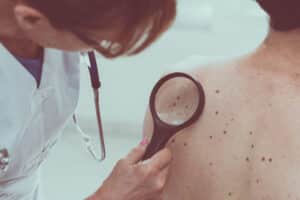 When we hear of skin cancer, we are often told to monitor preexisting moles for changes. While this is good overall advice, it is important that patients understand that skin cancer can present in many different ways and not just in moles. Additionally, the presence of moles doesn’t mean that a patient has skin cancer, either. If you are interested in learning more about moles and their link to cancer, continue reading!
When we hear of skin cancer, we are often told to monitor preexisting moles for changes. While this is good overall advice, it is important that patients understand that skin cancer can present in many different ways and not just in moles. Additionally, the presence of moles doesn’t mean that a patient has skin cancer, either. If you are interested in learning more about moles and their link to cancer, continue reading!
What are moles?
Dr. Fiona Wright of Skin M.D. and Beyond describes moles as skin growths sometimes referred to as “nevi” or “nevus” that can appear anywhere on the skin. They range in color from natural skin to darker browns and blacks. Most patients will have moles develop in their early childhood years and remain from there on out. However, just because moles are present doesn’t mean that they are cancerous. Most moles are benign, but changes to the mole may indicate a problem that might need further evaluation by a dermatologist.
What should I look for in cancerous moles?
The primary concern with moles is if they become cancerous, they often show visible changes that may indicate an issue is present. This means that the mole itself may change in shape, size, color, symmetry, or border color. When this happens, it may raise a red flag for cancer and should be evaluated by a dermatologist. Patients who have moles that are not changing in appearance should still have annual skin cancer screenings to monitor these moles for changes in the future. It is highly recommended that everyone visit a dermatologist once a year for a full body skin cancer screening, as many cases of skin cancer can be addressed early on with successful results.
Do you have concerns about moles on the skin?
It is best to be proactive about your concerns and schedule an appointment with Dr. Fiona Wright and her team at Skin M.D. and Beyond for a full evaluation. The office, located at 6517 Preston Road, is available for new and established patients seeking dermatological care. Call (972) 608-0808 to request an appointment and get started with routine skin evaluations to monitor for the early signs of skin cancer.

